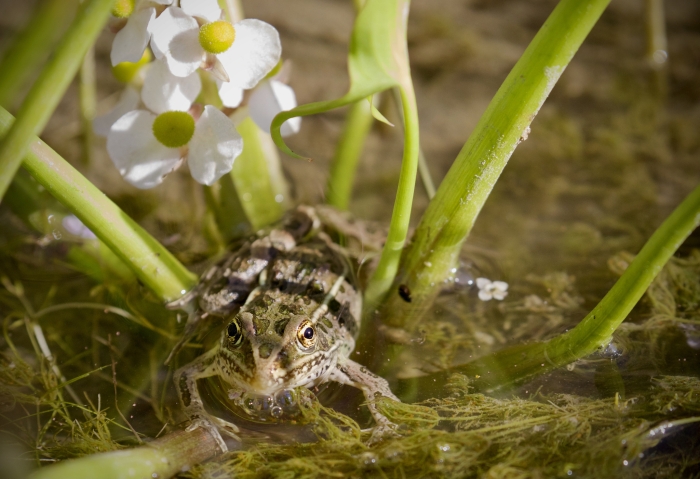Arumleaf Arrowhead
(Sagittaria cuneata)
Arumleaf Arrowhead (Sagittaria cuneata)
/
/

John Krampl
CC BY 4.0
Image By:
John Krampl
Recorded By:
Copyright:
CC BY 4.0
Copyright Notice:
Photo by: John Krampl | License Type: CC BY 4.0 | License URL: http://creativecommons.org/licenses/by/4.0/ | Rights Holder: John Krampl | Publisher: iNaturalist | Date Created: 2023-07-27T08:21:46-07:00 |
























Estimated Native Range
Summary
Sagittaria cuneata, commonly known as arumleaf arrowhead or duck potato, is a perennial herbaceous aquatic plant native to shallow wetlands, marshes, and the edges of ponds and slow-moving streams across North America. It typically grows from a tuber and features variable-shaped leaves that are often distinctly arrow-shaped with pointed lobes. This species reaches a height of 1-3 feet (30-90 cm) and spreads to form colonies. The plant blooms from mid-summer to early fall, producing showy white flowers with three petals and bright yellow stamens, which are attractive to pollinators such as bees and butterflies.
Arumleaf arrowhead is valued for its ornamental flowers and its role in aquatic and wetland gardens, providing habitat and food for wildlife. It is also of historical significance as a food source for Indigenous peoples, who harvested its starchy tubers. In cultivation, it requires a wet or consistently moist environment, and it thrives in full sun to part shade. While it is adaptable to various soil types, it prefers those that are muddy and nutrient-rich. It is not commonly afflicted by diseases, but gardeners should be aware of its potential to spread if conditions are ideal. Due to its endangered status in certain states, care should be taken to source plants responsibly and avoid introducing them into natural habitats where they are not already present.CC BY-SA 4.0
Arumleaf arrowhead is valued for its ornamental flowers and its role in aquatic and wetland gardens, providing habitat and food for wildlife. It is also of historical significance as a food source for Indigenous peoples, who harvested its starchy tubers. In cultivation, it requires a wet or consistently moist environment, and it thrives in full sun to part shade. While it is adaptable to various soil types, it prefers those that are muddy and nutrient-rich. It is not commonly afflicted by diseases, but gardeners should be aware of its potential to spread if conditions are ideal. Due to its endangered status in certain states, care should be taken to source plants responsibly and avoid introducing them into natural habitats where they are not already present.CC BY-SA 4.0
Plant Description
- Plant Type: Herb
- Height: 1-3.3 feet
- Width: 1-3.3 feet
- Growth Rate: Moderate
- Flower Color: White
- Flowering Season: Summer, Fall
- Leaf Retention: Deciduous
Growth Requirements
- Sun: Full Sun, Part Shade
- Water: Medium
- Drainage: Medium, Slow
Common Uses
Bird Garden, Low Maintenance, Water Garden
Natural Habitat
Shallow wetlands, marshes, and the edges of ponds and slow-moving streams
Other Names
Common Names: Duck Potato, Arrowleaf Sagittaria, Northern Arrowhead, Nothern Arrowhead, Wapato, Arum-Leaved Arrowhead, Duck-Potato Arrowhead, Tule Potato, Wapatum Arrowhead
Scientific Names: , Sagittaria cuneata, Sagittaria arifolia, Sagittaria arifolia, Sagittaria arifolia var. aquatilis, Sagittaria arifolia var. aquatilis, Sagittaria arifolia var. cuneata, Sagittaria arifolia var. dimorpha, Sagittaria arifolia var. monomorpha, Sagittaria arifolia var. polymorpha
GBIF Accepted Name: